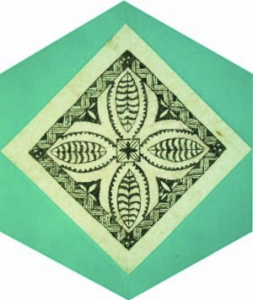Tonga

The Block
This block exemplifies one of Tonga’s most famous handcrafts – ngatu or tapa cloth. The design, by Penny Fraser and Penny Kobrynovich, features a stylized Heilala, Tonga’s national flower, which is honoured annually in such events as the Heilala Festival and the Miss Heilala competition. It also incorporates several traditional tapa cloth motifs. The labourious process of making ngatu begins by stripping the inner bark of paper mulberry trees and hanging the pieces in the sun to dry. They are soaked in water overnight and then each tutu, as the bark is now called, is beaten with an ike, a wooden mallet, on a tutua, a long wooden log. They are again hung up to dry and then joined together with glue made from tapioca or cassava to create larger sections. Once the pieces have been connected, the design process begins with the use of a kupesi board or stencil.
Designs are printed in traditional repeated patterns over the entire length of ngatu using plant-based dyes and left to dry once again. The final step is to repaint the pattern with natural dyes in different shades of black and brown. A craft treasured from generation to generation, ngatu cloth was historically used for clothing and bedding and still plays an important role in Tongan social life. It is given––in large quantities––as gifts at such events as weddings, royal occasions and funerals. It is also used for such things as mats, basket linings and wall hangings. In addition to carrying on the traditions of the Tongan people, the process of ngatu-making is also a primary source of news and information, for it is while working daily side-by-side that women share tales of the past and current stories.
Cultural Profile
Tonga, an independent island nation in the southern Pacific Ocean, is located approximately 650 kilometres southeast of Fiji. It is comprised of more than 170 islands––about 40 of which are inhabited––divided into three main groups: Tongatapu, Ha’apai, and Vava’u. Several of the islands are volcanic, with active craters, although most are coral atolls. James Cook arrived in Tonga in 1773 during one of the harvest feasts, to which he was invited. He therefore nicknamed Tonga ‘The Friendly Islands’—a name that islanders are still very proud of. Tonga is the only remaining Polynesian monarchy. Nearly two-thirds of its population, mostly Polynesian, live on Tongatapu and English and Tongan are the official languages.
One of Tonga’s most impressive sights is the Blow Holes along Houma’s coastline. The area is known as Mapu’aVaea or the ‘Chief’s Whistle’ because of the sound made by sea water spurting into the air through holes in the coral reefs. Tonga is also home to several colonies of flying fox, large fruit bats that are revered and protected on the islands.
Sponsor: Julie Clingman
